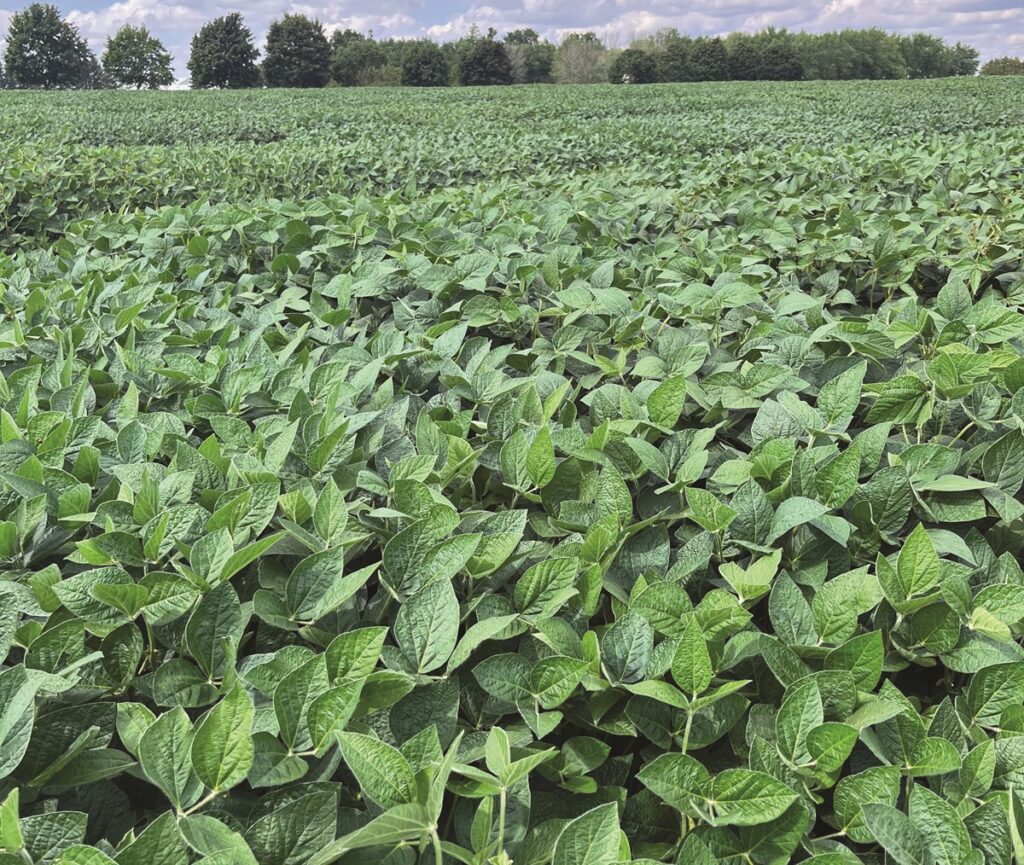Fighting soybean disease
RESEARCHERS FOCUS ON SCN AND WHITE MOLD

ONTARIO IS THE 10TH LARGEST SOYBEAN PRODUCING REGION in the world and is home to a variety of innovative research programs that advance crop production and market opportunities.
Developing integrated disease management strategies and breeding for disease resistance are key research areas to help farmers protect soybean yield.
Two three-year research projects that support the management of soybean cyst nematode (SCN) and white mold will conclude in 2024.
THE SCN COALITION
SCN is the most yield-limiting disease and plant health issue in soybeans in North America and is estimated to cost farmers $1 billion (USD) annually.
While the most significant losses are currently in the U.S., Ontario losses are expected to increase rapidly in the coming years as the erosion of SCN resistance (conferred by P188788 genetics) becomes more widespread. The issue is also becoming more present in Quebec and Manitoba.
Dr. Milad Eskandari, associate professor and plant breeder at the University of Guelph, and Albert Tenuta, field crop plant pathologist, Ontario Ministry of Agriculture, Food and Rural Affairs (OMAFRA), have worked to advance SCN research and increase grower awareness through a multifaceted project.
Their objectives included surveying Ontario fields for nematode population and distribution, evaluating nematicides and other products for SCN control, and continuing to work with the SCN Coalition, a partnership with university scientists from 28 US states, commodity boards, and other stakeholders.
“By partnering with our colleagues, from both extension and research, we’re able to utilize our strengths and resources to maximize our efforts and ultimately get one message and one voice across to soybean producers in North America,” says Tenuta.
PRACTICAL RESEARCH
Soil samples collected across the province confirm that all soybean- producing areas have SCN. As expected, the highest frequency was in the southwest (Oxford to Essex counties), although detection continues to increase in Northumberland and eastern counties. The root lesion nematode was the most widespread nematode found.
SCN seed treatment field trials (including sites in Rodney and Highgate, Ontario) showed that environmental factors strongly impact treatment efficiency. No one seed treatment ranks higher in SCN management over all environments, but ILEVO did reduce SCN infection on roots more effectively than Saltro in most instances.
The Ontario field trial data showed that nematicide seed treatments are most effective when used on an SCN-resistant variety.
TURNING UP THE VOLUME
Tenuta is the only Canadian representative on the SCN Coalition and has taken a leadership role in knowledge transfer activities, including organizing a successful National Soybean Nematode Conference in 2022.
The partners reach 10,000 North American soybean growers per year through extension publications, field days, and presentations. The group has been recognized with numerous awards for excellence in marketing and promotions.
“By increasing awareness, the active management by growers, as well as industry, is increasing in terms of looking at being the most effective at managing SCN with the tools that we have available to us right now, but also thinking about the future,” Tenuta says.
The SCN Coalition recently developed the SCN Profit Checker calculator (thescncoalition.com/profitchecker) as a tool to help growers determine how much SCN is costing them in both yield and dollars.
PRACTICAL RECOMMENDATIONS
“What’s your Number? Take the Test. Beat the Pest.” is the tagline of the SCN Coalition. Eskandari and Tenuta recommend six steps for Ontario growers to plan an integrated SCN management action program.
- Test fields to know SCN numbers
- Rotate resistant varieties and different SCN resistance sources (including Peking)
- Rotate non-host crops such as wheat and corn
- Look for Sudden Death Syndrome (SDS) and other diseases
- Consider a nematode-protectant seed treatment
- Retest fields every four to six years to evaluate progress
Additional resources are available at thescncoalition.com.
This project was funded by Grain Farmers of Ontario and the Canadian Agricultural Partnership (CAP), a five-year federal-provincial-territorial initiative.
BREEDING FOR SCN AND WHITE MOLD
Soybean breeders are also working to advance disease management. Dr. Istvan Rajcan, professor and graduate coordinator at the University of Guelph, recently led a project to increase the efficiency of selection for SCN resistance and white mold resistance in the breeding program.
High throughput marker-assisted selection (MAS) for resistance traits was used annually in F4 and F5 soybean breeding populations. This method of selecting disease-resistant genes is significantly more efficient than phenotypic selection based on characteristics such as visual agronomic performance, maturity, number of pods per plant and absence of disease, and lodging.
“When we use molecular markers, we can select the plants that will carry the resistance genes at the DNA level and not waste time or resources on testing materials in the field that don’t carry the resistance, and we do not want as new varieties,” explains Rajcan.
While the project concept is relatively simple, he says the funding enabled researchers to assess a greater number of populations than they would have otherwise been able to.
Crosses were initially made between SCN-resistant or white mold-resistant parents and high-yielding, high-quality food-grade soybean parents. The University of Guelph uses a nursery in Costa Rica to advance breeding materials to produce F4 populations over the winter months. From selected F4 plants, F5 generations are grown as single rows for selection in Woodstock the following year. Selected F5 single rows are grown in future trials in Woodstock, Elora, and St. Marys as recombinant inbred lines and tested for yield and agronomic traits. In this project, the marker-assisted selection occurred at both the F4 and F5 stages of the program to increase the number of resistant progenies selected for agronomic performance.
Essentially, we are arming our varieties with more resistance genes through the use of molecular markers and increasing the efficiency of developing new cultivars, which means more new disease-resistant and high-yielding food-grade soybean varieties will become available to farmers,” says Rajcan.
Since the breeding process takes eight years, varieties developed from the initial crosses made in 2021 are expected to come to market in 2029.
This project was funded by Grain Farmers of Ontario and the Ontario Agri-Food Innovation Alliance, a collaboration between the government of Ontario and the University of Guelph. •

























